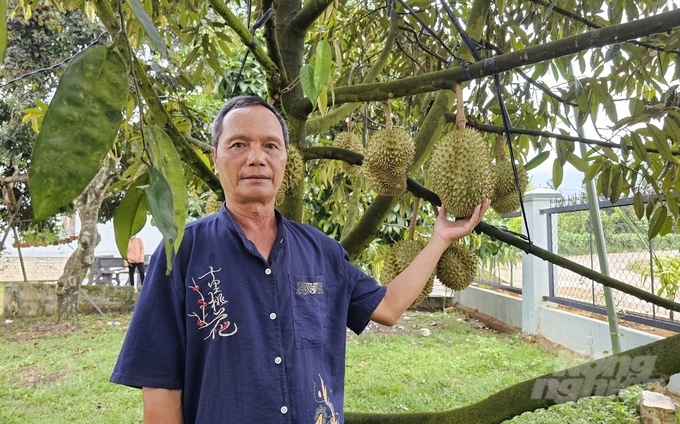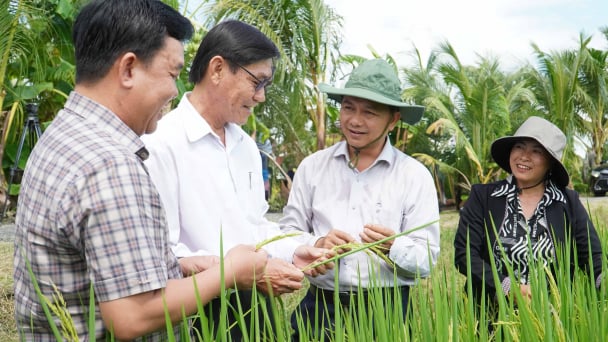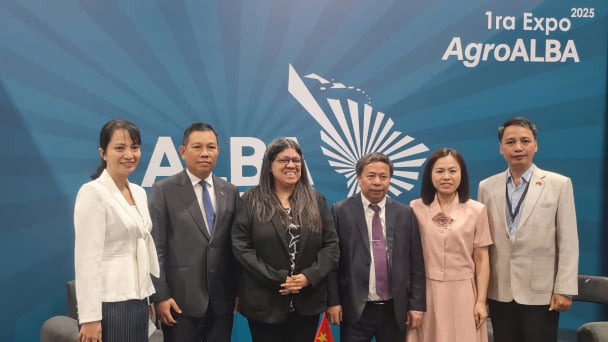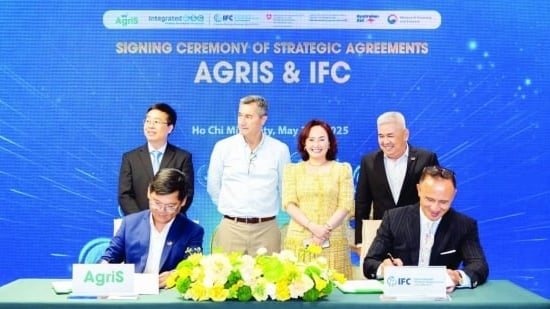June 20, 2025 | 00:43 GMT +7
June 20, 2025 | 00:43 GMT +7
Hotline: 0913.378.918
June 20, 2025 | 00:43 GMT +7
Hotline: 0913.378.918
Son Binh commune, also known as the durian "capital", is located eight kilometers west of the center of Khanh Son mountainous district, Khanh Hoa province.
Son Binh commune is currently in the durian season. As a result, its roads and houses are filled with freshly harvested durians waiting for traders. Many local households have made a fortune thanks to the record-high prices of Khanh Son durian this year.

Mr. Le Anh Quang from Lien Hoa village, Son Binh commune, earns an average of 1 billion VND per year from durian farming. Photo: Kim So.
Mr. Le Anh Quang, a durian farmer in Lien Hoa village, Son Binh commune, shared: "Khanh Son has become a rich commune full of billionaires". According to him, farmers in the district have bought twenty new cars within last month and paid the deposits for eighty additional cars.
According to Mr. Quang, his family currently grows 3.5 hectares of durian, which includes 1.5 hectares of harvested area. His family earns an average of 1 billion VND in profit every year. “The family's durian crop yielded 25 tons this year. We sold them at the price of 80,000 VND per kilogram. After deducting costs, we earn over 1.5 billion VND in profit. The breakthrough in durian price is the result of production unit codes. As a result, many businesses and traders have rushed to buy and export durians to the Chinese market", Mr. Quang added.
According to Mr. Van Tan Dat in Lien Hoa village, Son Binh commune, his family grew pepper and coffee at a relatively low efficiency. After researching, he found that durian trees were effective and suitable for the local climate and soil, so he converted his family production area to grow durian.
His family has planted 5 hectares of durian, which includes 2 hectares of harvested area. Mr. Dat earns an average of 800 million to 1 billion VND in profit every year. Thanks to a bountiful durian harvest this year and the high selling prices, his family earned over 1.5 billion VND in profit after deducting interest costs.
“My family has several kids, and we have had difficulties in the past. We struggled to survive in our run-down home. Thanks to the conversion to durian farming, the family's economy has improved and stabilized. We recently spent approximately 1.5 billion VND to construct a Thai roof house", Mr. Dat said.

Thanks to the conversion to durian farming, Mr. Van Tan Dat's family's economy has improved and stabilized. His family recently spent approximately 1.5 billion VND to construct a Thai roof house. Photo: Kim So.
Son Binh is one of seven communes in Khanh Son mountainous district, with the Raglai ethnic minorities making up 75% of its population. The proportion of impoverished and near-impoverished households in the commune accounted for more than 61% in the past. However, many farmers in the commune have made a living of durian farming.
According to Mr. Le Van Ha, Chairman of the Farmers' Association of Son Binh commune, the locals mainly relied on low-income coffee and pepper production so they struggled with poverty. Durian trees have been present in Son Binh commune since 2000, supported by a project in Khanh Son district. The majority of durian varieties were initially prioritized to support the Raglai people. However, these farmers were inefficient due to a lack of experience and technique.
Mr. Cao Van Sang in Son Binh commune was the first to successfully earn high profits from durian farming. As a result, local farmers acknowledged the effectiveness of durian trees and began producing them on a large scale.
Due to a lack of durian traders in the early harvest seasons, farmers carried baskets of durian to sell at markets, resulting in limited consumption. Traders started frequenting the commune by 2015, at which time durian farming in Son Binh commune has become popular.
Compared to other plants, durian has a higher economic efficiency. Consequently, farmers gradually convert from coffee to durian farming in the form of intercropping. Namely, farmers begin cutting down coffee trees when the durian trees reach their adulthood. This method allows farmers to utilize profits from coffee trees to invest in durian trees.
One hectare of durian trees in Son Binh commune currently has an average yield of 20 tons. At an average selling price of 75,000 VND per kilogram, farmers can earn up to 1.5 billion VND in profits. Investment costs for durian trees are relatively low. Most notably, materials such as fertilizer, water, medicine, etc. only account for 20 to 30% of the revenue.

Households in Khanh Son district currently earn between 1 and 20 billion VND per year thanks to durian. Photo: Kim So.
Son Binh commune currently harvests roughly 2,000 tons of durian annually from 430 hectares of land, 200 of which are in production. The total number of durian farming households in the commune has reached 500 households, 300 of which own at least one hectare of land. The number of households that earn between 1 and 20 billion VND has reached approximately 100.
Most notably, several households only grow durian in an area of 0.5 to 0.7 hectares. However, by mastering care techniques, these farmers achieve high productivity and earn over 1 billion VND in profits. Mr. Vo Hoai Phuong only grows durian on 0.7 hectares of land but he earns 1.8 billion VND in profits. Son Binh commune currently has eight households with an annual income of nearly 10 billion VND.
On the other hand, durian trees also help provide employment opportunities and reduce the rate of poverty. The entire commune only had 127 impoverished households by June 2023, accounting for 12% of the total 1,024 households. When local durian trees their fourth or fifth year in 2024, farmers can begin the harvest season. Subsequently, farmers only need to grow a small number of durian trees at the current selling price to escape poverty.
"The price of durian results in increased land prices, increased labor costs, and additional employment opportunities. In the past, people in the commune had to travel to other regions to find work. However, the number of jobs in the commune is now in high demand", said Mr. Le Van Ha.
In order to improve the quality of durian for export, Son Binh commune has established four fruit production cooperative groups. Accordingly, the production area will house two cooperative groups with 37 households. The commune aims to acquire a production unit code for an area of 90 hectares. So far, the remaining two cooperative groups have also submitted documents to be granted production unit codes.
Translated by Nguyen Hai Long
/2025/06/17/3942-2-143243_548.jpg)
(VAN) Recently, in Sweden, the Secretary of the Binh Dinh Provincial Party Committee presented the Investment Registration Certificate for the 'Polyester Fabric Recycling Complex' project to SYRE Impact-AB Company.
/2025/06/12/3721-2-202745_83.jpg)
(VAN) TH made an impression at Seoul Food 2025 with its line of natural beverages, paving the way for Vietnamese food products to enter the South Korean market.

(VAN) Soc Trang's success in rice exports stems from a strategy of developing fragrant and specialty rice cultivation areas and standardizing production toward low-emission practices.
/2025/06/11/1311-5-120811_839.jpg)
(VAN) The pig farming industry is facing the challenge of comprehensive restructuring to meet requirements for quality, safety, traceability, and market expansion both domestically and for export.

(VAN) Vietnam considers participating in ALGROALBA in order to expand agricultural production, coordinate the assessment and effective exploitation potential land.
/2025/06/05/5314-1-184727_407.jpg)
(VAN) From seemingly worthless fish scales and skin, enzymes and lactic ferments can transform by-products into peptides, opening a sustainable, effective business direction and elevating Vietnamese seafood.

(VAN) TTC AgriS and IFC signed a strategic partnership to develop a sustainable agricultural value chain, aiming to achieve the Net Zero target by 2035.